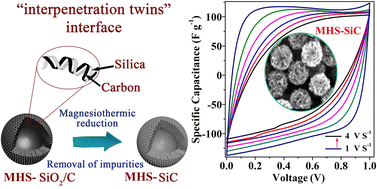Jianhua Hou, Liang Fang, Xiaozhi Wang, Hong Gao and Guoxiu Wang
Chem. Commun., 2022,58, 12455-12458
DOI:
10.1039/D2CC04723C,
Communication
In this work, mesoporous hollow SiC nanospheres (MHS-SiC) are successfully fabricated via in situ magnesiothermic reduction of mesoporous hollow carbon-silica nanospheres (MHS-SiO2/C), which inherit a unique interconnected network on the shell. The specially designed interpenetrating shell structure provides an accessible interface between Si and C elements in a confined nanospace during magnesiothermic reduction, and thus well-dispersed MHS-SiC nanospheres (∼95 nm in diameter) with interconnected mesoporous shells and high specific surface area (868 m2 g−1) can be obtained. For practical applications, the obtained MHS-SiC electrode exhibits a high-rate capacitance and long cycling stability for supercapacitors.
